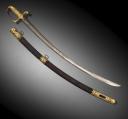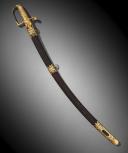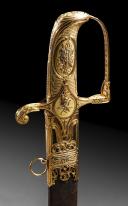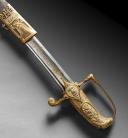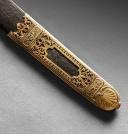
Ceremonial sabre in gold and diamonds, belonging to the last king of Poland: Stanislas II Auguste Poniatowski, 1764-1795. From the Philippe Missillier Collection, being auctioned at Giquello, Drouot - rooms 5-6, on March 6th and 7th, 2025.
Sold out
PHILIPPE MISSILLIER COLLECTION
EARLY PERIOD – BOOKS – FIREARMS FROM THE 17TH CENTURY
HUNTING ART – PHALERISTICS
18TH AND 19TH CENTURY WEAPONS – RUSSIAN ART
Friday, March 7, 2025 - 11 am to 12 pm
AFRICA AND OCEANIA – FAR EAST
Friday, March 7, 2025 - 2 pm
ISLAMIC AND INDIAN ART
Drouot - rooms 5-6
EXHIBITION
Tuesday, March 4 from 11 am to 6 pm
Wednesday, March 5 from 11 am to 6 pm
Thursday, March 6 from 11 am to 12 pm
Telephone during the exhibition +33(0)1 48 00 20 05
GIQUELLO
Alexandre Giquello
Violette Stcherbatcheff
5, rue La Boétie - 75008 Paris
+33 (0)1 47 42 78 01 - info@giquello.net
with agreement
no. 2002 389
CONTACT
Claire Richon
+33(0)1 47 70 48 00
c.richon@giquello.net
EXPERT
Bertrand Malvaux, CNES
Lot No. 226 (from the auction)
Ceremonial sabre in gold and diamonds of the last King of Poland: Stanislas II Auguste Poniatowski, 1764-1795.
Hilt and all scabbard fittings in four-color gold (yellow, pink, green, and white), guard adorned with diamonds.
Single-branch guard, characteristic of light cavalry units in 18th-century Europe. The guard branch is flat and intricately pierced with a frieze of foliate oves. The right angle of the guard branch and its significant quillon with scrollwork are applied with large acanthus leaves in finely engraved gold. The two gold earpieces are cross-shaped, applied on either side of the straight guard; the end of the vertical arms is engraved with a floral motif. Each earring features a central tondo with a relief motif, on the outer face a bust of a helmeted warrior dressed "antique" style (Mars), and on the inner face a trophy of bow and quiver on laurel branches. Two rose-cut diamonds are set on either side of the horizontal crosspiece of the outer earpiece. A rose-cut diamond is set in a foliate engraving on the upper part of the inner tondo. A gold oval chape cover with guilloché border is attached below the guard, fitting over the top of the chape. Gold pommel with rounded shape, engraved with relief foliage on a matte background, with finely engraved beaded edges. The handle is entirely engraved simulating a plain filigree, bordered by a branch of acanthus leaves. Both faces are decorated with a large oval reserve, embossed in relief on a matte gold background with a trophy of arms: armor, plumed helmet, and a bunch of flags on the outer face; shield, sword, and a bunch of flags on the inner face.
European blade in damascus steel, slightly curved, with a flat back and grooves. It bears gold inscriptions on the straight hollow edge. At the heel, reading upwards, the royal monogram under a crown is inlaid: S A (Stanislas Augustus). Reading from the heel to the tip, edge upwards, a cursive Arabic inscription in raised gold reads: "la tashabni illa fi mahall al-darur[a] wa la taj'alni fi makani illa b'il-'izz wa'l-takrim," which can be translated into French as "Do not draw me without reason, do not sheathe me without glory or honor."
Wood scabbard covered in black shagreen. It features three finely cut and intricately engraved gold fittings with a symmetrical design on both sides and in harmony with the handle's decoration. Rectangular reserves with notched corners are embossed with military trophies on a matte background. The chape and bracelet each bear a faceted gold bale ring. The long drag, with a button tip, is widely pierced and has a large shell at its lower end.
Poland, circa 1770-1775.
Owl hallmark on the handle and upper part of the scabbard.
Length: 96 cm.
Gross weight: 1092 gr.
Poland.
18th century, circa 1770-1775.
Perfect condition.
500000/700000
Provenance: While Stanislas Auguste fathered several illegitimate children, he was never married and therefore had no direct legal heir before his death on February 12, 1798. According to Polish elective monarchy, the king's personal belongings were to be inherited by the king's heirs. Thus, Stanislas II Auguste's universal legatee was his nephew, Prince Józef Antoni Poniatowski (1763-1813). Józef offered a sabre to Napoleon, gave the second one to the Wodziński family (as we will detail later), and most likely kept the third version for himself.
Józef Antoni was unable to complete the liquidation of the entire inheritance before his death in the Battle of Leipzig on October 19, 1813. His properties then passed to his sister Maria Teresa Poniatowska Tyszkiewiczowa (1760-1834), who had lived in France since 1807 and was the mistress of Charles-Maurice de Talleyrand-Périgord (1754-1838), Prince de Bénévent. In November 1813, Maria Teresa gave power of attorney to Aleksander Linowski, the executor of her brother's estate, to settle her inheritance. Between 1814 and 1819, Stanislas Auguste's properties were auctioned off. In 1817, Maria Teresa sold the Łazienki Palace in Warsaw to Tsar Alexander I with all its furnishings. The remaining assets of the former King of Poland were purchased in 1821 by Antonio Fusi of Milan.
Maria Teresa died in Tours in 1834.
— Stanislas II Auguste, the last King of Poland (r. 1764-1795), circa 1770-1775,
— Prince Józef Antoni Poniatowski, the king's nephew, by inheritance in 1798,
— Maria Teresa Poniatowska Tyszkiewiczowa, sister of the prince, by inheritance in 1813,
— Probably Antonio Fusi, jeweler in Milan, in 1821,
— Sapjo, antique dealer - jeweler in Monte-Carlo (Principality of Monaco), before 1990,
— Private collection, acquired from the previous at the Paris Biennale des Antiquaires in 1990,
— Philippe Missillier Collection.
Note: The catalog of the 15th International Biennale of Paris in 1990 featured the sabre across two pages by the antique dealer and jeweler Mr. Sapjo, erroneously stating the provenance as "Former collection of Jean-Jacques Reubell." Although this sabre bears resemblance to the "Reubell sabre" descriptions, it does not feature the two side guard rings, the two engraved coats of arms and Polish names, or a damascus steel blade as described in the 1933 and 1964 catalogs.
The presumed goldsmith of the three ornate sabres of King Stanislas II Auguste.
Examining the descriptions and images of these three sabres suggests that they were all crafted by the same goldsmith.
The goldsmith of these three precious gold sabres is most likely Joachim Friedrich Jacobson, known to be active in Warsaw from 1750 to 1776, who fulfilled orders for King Stanislas II Auguste and his court. In 1764, Jacobson crafted the renowned sword of the Order of the White Eagle, designed by Polish architect Efraïm Schröger (1727-1783), now housed in the Royal Castle Museum in Warsaw (inv. ZKW 1251/a, b). Stanislas II Auguste was portrayed wearing this sword during his coronation. Jacobson also created collars for the Royal Order of the White Eagle of Poland.
Biography: Stanislas-Auguste, the fourth son of Count Stanislas Poniatowski (1676-1762), Castellan of Cracow from the highest Polish nobility, and Princess Constance Czartoryska, was born on January 17, 1732, in Wołczyn.
In 1748, he began traveling and visited Germany, the Netherlands, and Austria. In 1752, his father purchased for him the title of Starost of Przemyśl, which allowed him to enter the parliament. In 1753, he resumed his travels to Hungary, Austria, the Netherlands, Paris (where he mingled with the intellectual elite), and London. In 1754, he returned to Poland and was appointed Panetier of Lithuania (stolnik litewski). In 1755, he was sent to Russia to serve under his mentor and friend, Sir Charles Hanbury Williams (1708-1759), appointed British Ambassador to Saint Petersburg. It was there that Stanislas-Auguste met the Grand Duchess and Imperial Highness Catherine Alexeïevna (1729-1796), wife of the Crown Prince Peter Fedorovitch (1728-1762), mother of Paul Petrovitch (1754-1801), and future Catherine II of Russia.
A passionate and tumultuous relationship ensued. Due to court intrigues against him, Stanislas-Auguste had to leave St. Petersburg in 1758. Back in Poland, he pursued a pro-Russian and anti-Prussian policy.
King August III of Poland died in October 1763, and Stanislas-Auguste Poniatowski ran for election as the new king of the aristocratic Republic of the Two Nations. Financially and militarily supported by Empress Catherine II, he was elected on September 7, 1764, and crowned on November 25. Thus, by the grace of God and the will of the people, he became King of Poland, Grand Duke of Lithuania and Duke of Ruthenia, Prussia, Masovia, Samogitia, Kiev, Volhynia, Podolia, Podlaskie, Livonia, Smolensk, Sievers, and Chernihiv. Stanislas II Auguste immediately aimed to reform the government by reducing the powers of high military commanders (hetmans) and treasurers, instituting a policy to protect religious minorities, and especially abolishing the unanimity rule (liberum veto) that severely limited the decisions of the deliberative chamber. He faced strong opposition stirred up by Russia, which wanted to keep a weak Poland-Lithuania under its tutelage. Russian interference in Poland's affairs led to an insurrection, the Bar Confederation, directed against the king supported by Catherine II, which turned into a lengthy civil war from 1768 to 1772. The Confederation proclaimed the dethronement of Stanislas II Auguste in 1771, but was forced to surrender in 1772, crushed by Russian troops. This provided an opportunity for Russia and its allies, the Kingdom of Prussia and the Austrian Empire, to partially partition Poland.
The king lost the right to grant titles and appoint military officers, ministers, and senators. Crown lands were auctioned off. However, Stanislas II Auguste managed to stay on the throne and, from 1776, called for the drafting of a civil code.
On May 3, 1791, he enacted one of Europe's first constitutions, then requested the development of a civil and penal code. Seeing this as a threat to their privileges, the Polish nobility decided to overturn the Constitution, rebellion formed as the Targowica Confederation and sought Russian assistance. In 1792, with overwhelming Russian military superiority, Stanislas II Auguste chose surrender. The Polish army was disbanded, the constitution revoked, and a second partition of Poland occurred.
In 1794, he supported the Kościuszko Uprising against Russia, but it resulted in a crushing defeat inflicted by Russian General Alexander Suvorov, who occupied Warsaw. Empress Catherine II ordered Stanislas II Auguste to leave the capital for Grodno under Russian military escort. In 1795, a third partition of Poland led to the kingdom's disappearance. Austria took control of Galicia and the Krakow region, Prussia took over Poznań and the Warsaw area, and Russia took over the Grand Duchy of Lithuania. The King Stanislas II Auguste was forced to abdicate on November 25, 1795.
Catherine II died in November 1796, and her son, Paul I (r. 1796-1801), succeeded her. Summoned to go to St. Petersburg, Stanislas-Auguste left Grodno on February 15, 1797. He was allocated a virtual prison, the Marble Palace, where Count Grigori Orlov, another favorite of Catherine the Great, had resided. Stanislas-Auguste Poniatowski perished there on February 12, 1798.
Known Copies: Three ornate gold ceremonial sabres of King Stanislas II Auguste Poniatowski (r. 1764-1795) are currently documented.
-1- A gold and enameled ceremonial sabre of King Stanislas II Auguste, is part of the collections of the Army Museum, Hôtel des Invalides in Paris.
Gold and enameled hilt in dark blue and white, with diamond inlays. Single-branch guard of a type specific to Poland, with two lateral rings fixed on either side of the horizontal right quillon. Pommel with a long tail, topped with an oval reserve inlaid with a monogram in rose-cut diamonds: S. A. R. intertwined (Stanislas Augustus Rex). Each earring features a central tondo, with a dark blue enameled background, painted with a grey portrait of "Minerva" on the outer face and "Mars" on the inner face. The straight blade, with a flat back, in damascus steel with a gold decoration on either side: a left side damascened with Arabic cursive characters; a right side with the profile of King Stephen Báthory, at the heel, followed by the inscription in Latin capitals "STEPHANUS .BATOREUS . REX . POLONIAE . A[nno] . D[omini] . 1575." The straight scabbard, with gold fittings, bears a darkened calf leather coating with a decor of enameled trophies. This sabre is commonly attributed to Poland and dated around 1780.
Inherited from King Stanislas II Auguste, this precious sabre was gifted by Prince Józef Antoni Poniatowski to Emperor Napoleon I during his stay in Warsaw in January 1807, when he resided in the royal castle, rearranged by the last King of Poland.
In Napoleon's holographic will, drafted on April 15, 1821, he bequeathed this sabre to his son born in 1811, former King of Rome (1814-1818). Count Henri-Gatien Bertrand (1773-1844), former Grand Marshal of the Emperor's Palace, was tasked to present it to him for his sixteenth birthday on March 20, 1827. Napoleon I's son died prematurely on July 22, 1832. Thus, the sabre was then attributed to Jérôme Bonaparte (1784-1860), the Emperor's youngest brother and King of Westphalia from 1807 to 1813, who gifted it to his son, Prince Napoléon-Jérôme (1822-1891), in 1840. The sabre was then acquired by another nephew of the Emperor, Louis-Napoléon (1808-1873), who at the time was the Prince-President before becoming Emperor of the French under the title Napoléon III.
On February 15, 1850, he presented the sabre to the Artillery Museum in Paris, now the Army Museum, with a catalogue published in 1862 by Octave Penguilly L’Haridon under No. J 92.
-2- The multi-colored gold ceremonial sabre of King Stanislas II Auguste, from the former Jean-Jacques Reubell Collection (1861-1933) in Paris.
This sabre is primarily known from the auction catalog of his collection, posthumously dispersed and conducted by Maîtres Henri Baudouin and Étienne Ader (auctioneers) on December 12, 1933, at the Hôtel Drouot in Paris. In lot 175 on page 34, the expert Henri Leman described it as follows: "Sabre with gold hilt and fittings, the handle decorated with gold foliate medallions in multiple colors representing arms and banner trophies. On the earpieces, a helmeted man bust and a trophy with bow and quiver. Single-branch guard with two rings under the thumb piece with two armorial bearings engraved and the name Maltzan Wodzinski. Black maroquin scabbard with finely cut and intricately engraved gold fittings with trophy decor. Curved blade, engraved with golden oriental inscriptions, and the S.A. cipher under a royal crown: Stanislas Auguste, king of Poland. Late 18th century. Length, 98 cent."
On December 6, 1964, Robert-Jean Charles (1904-1979), a Parisian expert, elaborated a description of this sabre probably at the request of the then owner: "Sabre of Stanislas II Auguste - King of Poland (1732+1798) King from 1764 to 1795." The second description of this sabre differs from that of the 1933 auction by the absence of the mention of two engraved coats of arms and Polish names. Robert-Jean Charles presumably regarded these later additions as historically unrelated to the sabre.
The dual coats of arms and two Polish names engraved, Maltzan and Wodziński, likely added on the blade posthumously by the recipient or his family, long after the king's death in 1798. Army General Ignacy Wodziński (1745-1815) served as an aide-de-camp to Stanislas II Auguste from 1777 and was a close friend. He offered to stay with the deposed king during his exile in Grodno (December 1794 - February 1797). This sabre was either presented as a gift before 1798 by Stanislas II Auguste to the general for his services to him; or after 1798, handed as a gift from Prince Józef Antoni Poniatowski to
EARLY PERIOD – BOOKS – FIREARMS FROM THE 17TH CENTURY
HUNTING ART – PHALERISTICS
18TH AND 19TH CENTURY WEAPONS – RUSSIAN ART
Friday, March 7, 2025 - 11 am to 12 pm
AFRICA AND OCEANIA – FAR EAST
Friday, March 7, 2025 - 2 pm
ISLAMIC AND INDIAN ART
Drouot - rooms 5-6
EXHIBITION
Tuesday, March 4 from 11 am to 6 pm
Wednesday, March 5 from 11 am to 6 pm
Thursday, March 6 from 11 am to 12 pm
Telephone during the exhibition +33(0)1 48 00 20 05
GIQUELLO
Alexandre Giquello
Violette Stcherbatcheff
5, rue La Boétie - 75008 Paris
+33 (0)1 47 42 78 01 - info@giquello.net
with agreement
no. 2002 389
CONTACT
Claire Richon
+33(0)1 47 70 48 00
c.richon@giquello.net
EXPERT
Bertrand Malvaux, CNES
Lot No. 226 (from the auction)
Ceremonial sabre in gold and diamonds of the last King of Poland: Stanislas II Auguste Poniatowski, 1764-1795.
Hilt and all scabbard fittings in four-color gold (yellow, pink, green, and white), guard adorned with diamonds.
Single-branch guard, characteristic of light cavalry units in 18th-century Europe. The guard branch is flat and intricately pierced with a frieze of foliate oves. The right angle of the guard branch and its significant quillon with scrollwork are applied with large acanthus leaves in finely engraved gold. The two gold earpieces are cross-shaped, applied on either side of the straight guard; the end of the vertical arms is engraved with a floral motif. Each earring features a central tondo with a relief motif, on the outer face a bust of a helmeted warrior dressed "antique" style (Mars), and on the inner face a trophy of bow and quiver on laurel branches. Two rose-cut diamonds are set on either side of the horizontal crosspiece of the outer earpiece. A rose-cut diamond is set in a foliate engraving on the upper part of the inner tondo. A gold oval chape cover with guilloché border is attached below the guard, fitting over the top of the chape. Gold pommel with rounded shape, engraved with relief foliage on a matte background, with finely engraved beaded edges. The handle is entirely engraved simulating a plain filigree, bordered by a branch of acanthus leaves. Both faces are decorated with a large oval reserve, embossed in relief on a matte gold background with a trophy of arms: armor, plumed helmet, and a bunch of flags on the outer face; shield, sword, and a bunch of flags on the inner face.
European blade in damascus steel, slightly curved, with a flat back and grooves. It bears gold inscriptions on the straight hollow edge. At the heel, reading upwards, the royal monogram under a crown is inlaid: S A (Stanislas Augustus). Reading from the heel to the tip, edge upwards, a cursive Arabic inscription in raised gold reads: "la tashabni illa fi mahall al-darur[a] wa la taj'alni fi makani illa b'il-'izz wa'l-takrim," which can be translated into French as "Do not draw me without reason, do not sheathe me without glory or honor."
Wood scabbard covered in black shagreen. It features three finely cut and intricately engraved gold fittings with a symmetrical design on both sides and in harmony with the handle's decoration. Rectangular reserves with notched corners are embossed with military trophies on a matte background. The chape and bracelet each bear a faceted gold bale ring. The long drag, with a button tip, is widely pierced and has a large shell at its lower end.
Poland, circa 1770-1775.
Owl hallmark on the handle and upper part of the scabbard.
Length: 96 cm.
Gross weight: 1092 gr.
Poland.
18th century, circa 1770-1775.
Perfect condition.
500000/700000
Provenance: While Stanislas Auguste fathered several illegitimate children, he was never married and therefore had no direct legal heir before his death on February 12, 1798. According to Polish elective monarchy, the king's personal belongings were to be inherited by the king's heirs. Thus, Stanislas II Auguste's universal legatee was his nephew, Prince Józef Antoni Poniatowski (1763-1813). Józef offered a sabre to Napoleon, gave the second one to the Wodziński family (as we will detail later), and most likely kept the third version for himself.
Józef Antoni was unable to complete the liquidation of the entire inheritance before his death in the Battle of Leipzig on October 19, 1813. His properties then passed to his sister Maria Teresa Poniatowska Tyszkiewiczowa (1760-1834), who had lived in France since 1807 and was the mistress of Charles-Maurice de Talleyrand-Périgord (1754-1838), Prince de Bénévent. In November 1813, Maria Teresa gave power of attorney to Aleksander Linowski, the executor of her brother's estate, to settle her inheritance. Between 1814 and 1819, Stanislas Auguste's properties were auctioned off. In 1817, Maria Teresa sold the Łazienki Palace in Warsaw to Tsar Alexander I with all its furnishings. The remaining assets of the former King of Poland were purchased in 1821 by Antonio Fusi of Milan.
Maria Teresa died in Tours in 1834.
— Stanislas II Auguste, the last King of Poland (r. 1764-1795), circa 1770-1775,
— Prince Józef Antoni Poniatowski, the king's nephew, by inheritance in 1798,
— Maria Teresa Poniatowska Tyszkiewiczowa, sister of the prince, by inheritance in 1813,
— Probably Antonio Fusi, jeweler in Milan, in 1821,
— Sapjo, antique dealer - jeweler in Monte-Carlo (Principality of Monaco), before 1990,
— Private collection, acquired from the previous at the Paris Biennale des Antiquaires in 1990,
— Philippe Missillier Collection.
Note: The catalog of the 15th International Biennale of Paris in 1990 featured the sabre across two pages by the antique dealer and jeweler Mr. Sapjo, erroneously stating the provenance as "Former collection of Jean-Jacques Reubell." Although this sabre bears resemblance to the "Reubell sabre" descriptions, it does not feature the two side guard rings, the two engraved coats of arms and Polish names, or a damascus steel blade as described in the 1933 and 1964 catalogs.
The presumed goldsmith of the three ornate sabres of King Stanislas II Auguste.
Examining the descriptions and images of these three sabres suggests that they were all crafted by the same goldsmith.
The goldsmith of these three precious gold sabres is most likely Joachim Friedrich Jacobson, known to be active in Warsaw from 1750 to 1776, who fulfilled orders for King Stanislas II Auguste and his court. In 1764, Jacobson crafted the renowned sword of the Order of the White Eagle, designed by Polish architect Efraïm Schröger (1727-1783), now housed in the Royal Castle Museum in Warsaw (inv. ZKW 1251/a, b). Stanislas II Auguste was portrayed wearing this sword during his coronation. Jacobson also created collars for the Royal Order of the White Eagle of Poland.
Biography: Stanislas-Auguste, the fourth son of Count Stanislas Poniatowski (1676-1762), Castellan of Cracow from the highest Polish nobility, and Princess Constance Czartoryska, was born on January 17, 1732, in Wołczyn.
In 1748, he began traveling and visited Germany, the Netherlands, and Austria. In 1752, his father purchased for him the title of Starost of Przemyśl, which allowed him to enter the parliament. In 1753, he resumed his travels to Hungary, Austria, the Netherlands, Paris (where he mingled with the intellectual elite), and London. In 1754, he returned to Poland and was appointed Panetier of Lithuania (stolnik litewski). In 1755, he was sent to Russia to serve under his mentor and friend, Sir Charles Hanbury Williams (1708-1759), appointed British Ambassador to Saint Petersburg. It was there that Stanislas-Auguste met the Grand Duchess and Imperial Highness Catherine Alexeïevna (1729-1796), wife of the Crown Prince Peter Fedorovitch (1728-1762), mother of Paul Petrovitch (1754-1801), and future Catherine II of Russia.
A passionate and tumultuous relationship ensued. Due to court intrigues against him, Stanislas-Auguste had to leave St. Petersburg in 1758. Back in Poland, he pursued a pro-Russian and anti-Prussian policy.
King August III of Poland died in October 1763, and Stanislas-Auguste Poniatowski ran for election as the new king of the aristocratic Republic of the Two Nations. Financially and militarily supported by Empress Catherine II, he was elected on September 7, 1764, and crowned on November 25. Thus, by the grace of God and the will of the people, he became King of Poland, Grand Duke of Lithuania and Duke of Ruthenia, Prussia, Masovia, Samogitia, Kiev, Volhynia, Podolia, Podlaskie, Livonia, Smolensk, Sievers, and Chernihiv. Stanislas II Auguste immediately aimed to reform the government by reducing the powers of high military commanders (hetmans) and treasurers, instituting a policy to protect religious minorities, and especially abolishing the unanimity rule (liberum veto) that severely limited the decisions of the deliberative chamber. He faced strong opposition stirred up by Russia, which wanted to keep a weak Poland-Lithuania under its tutelage. Russian interference in Poland's affairs led to an insurrection, the Bar Confederation, directed against the king supported by Catherine II, which turned into a lengthy civil war from 1768 to 1772. The Confederation proclaimed the dethronement of Stanislas II Auguste in 1771, but was forced to surrender in 1772, crushed by Russian troops. This provided an opportunity for Russia and its allies, the Kingdom of Prussia and the Austrian Empire, to partially partition Poland.
The king lost the right to grant titles and appoint military officers, ministers, and senators. Crown lands were auctioned off. However, Stanislas II Auguste managed to stay on the throne and, from 1776, called for the drafting of a civil code.
On May 3, 1791, he enacted one of Europe's first constitutions, then requested the development of a civil and penal code. Seeing this as a threat to their privileges, the Polish nobility decided to overturn the Constitution, rebellion formed as the Targowica Confederation and sought Russian assistance. In 1792, with overwhelming Russian military superiority, Stanislas II Auguste chose surrender. The Polish army was disbanded, the constitution revoked, and a second partition of Poland occurred.
In 1794, he supported the Kościuszko Uprising against Russia, but it resulted in a crushing defeat inflicted by Russian General Alexander Suvorov, who occupied Warsaw. Empress Catherine II ordered Stanislas II Auguste to leave the capital for Grodno under Russian military escort. In 1795, a third partition of Poland led to the kingdom's disappearance. Austria took control of Galicia and the Krakow region, Prussia took over Poznań and the Warsaw area, and Russia took over the Grand Duchy of Lithuania. The King Stanislas II Auguste was forced to abdicate on November 25, 1795.
Catherine II died in November 1796, and her son, Paul I (r. 1796-1801), succeeded her. Summoned to go to St. Petersburg, Stanislas-Auguste left Grodno on February 15, 1797. He was allocated a virtual prison, the Marble Palace, where Count Grigori Orlov, another favorite of Catherine the Great, had resided. Stanislas-Auguste Poniatowski perished there on February 12, 1798.
Known Copies: Three ornate gold ceremonial sabres of King Stanislas II Auguste Poniatowski (r. 1764-1795) are currently documented.
-1- A gold and enameled ceremonial sabre of King Stanislas II Auguste, is part of the collections of the Army Museum, Hôtel des Invalides in Paris.
Gold and enameled hilt in dark blue and white, with diamond inlays. Single-branch guard of a type specific to Poland, with two lateral rings fixed on either side of the horizontal right quillon. Pommel with a long tail, topped with an oval reserve inlaid with a monogram in rose-cut diamonds: S. A. R. intertwined (Stanislas Augustus Rex). Each earring features a central tondo, with a dark blue enameled background, painted with a grey portrait of "Minerva" on the outer face and "Mars" on the inner face. The straight blade, with a flat back, in damascus steel with a gold decoration on either side: a left side damascened with Arabic cursive characters; a right side with the profile of King Stephen Báthory, at the heel, followed by the inscription in Latin capitals "STEPHANUS .BATOREUS . REX . POLONIAE . A[nno] . D[omini] . 1575." The straight scabbard, with gold fittings, bears a darkened calf leather coating with a decor of enameled trophies. This sabre is commonly attributed to Poland and dated around 1780.
Inherited from King Stanislas II Auguste, this precious sabre was gifted by Prince Józef Antoni Poniatowski to Emperor Napoleon I during his stay in Warsaw in January 1807, when he resided in the royal castle, rearranged by the last King of Poland.
In Napoleon's holographic will, drafted on April 15, 1821, he bequeathed this sabre to his son born in 1811, former King of Rome (1814-1818). Count Henri-Gatien Bertrand (1773-1844), former Grand Marshal of the Emperor's Palace, was tasked to present it to him for his sixteenth birthday on March 20, 1827. Napoleon I's son died prematurely on July 22, 1832. Thus, the sabre was then attributed to Jérôme Bonaparte (1784-1860), the Emperor's youngest brother and King of Westphalia from 1807 to 1813, who gifted it to his son, Prince Napoléon-Jérôme (1822-1891), in 1840. The sabre was then acquired by another nephew of the Emperor, Louis-Napoléon (1808-1873), who at the time was the Prince-President before becoming Emperor of the French under the title Napoléon III.
On February 15, 1850, he presented the sabre to the Artillery Museum in Paris, now the Army Museum, with a catalogue published in 1862 by Octave Penguilly L’Haridon under No. J 92.
-2- The multi-colored gold ceremonial sabre of King Stanislas II Auguste, from the former Jean-Jacques Reubell Collection (1861-1933) in Paris.
This sabre is primarily known from the auction catalog of his collection, posthumously dispersed and conducted by Maîtres Henri Baudouin and Étienne Ader (auctioneers) on December 12, 1933, at the Hôtel Drouot in Paris. In lot 175 on page 34, the expert Henri Leman described it as follows: "Sabre with gold hilt and fittings, the handle decorated with gold foliate medallions in multiple colors representing arms and banner trophies. On the earpieces, a helmeted man bust and a trophy with bow and quiver. Single-branch guard with two rings under the thumb piece with two armorial bearings engraved and the name Maltzan Wodzinski. Black maroquin scabbard with finely cut and intricately engraved gold fittings with trophy decor. Curved blade, engraved with golden oriental inscriptions, and the S.A. cipher under a royal crown: Stanislas Auguste, king of Poland. Late 18th century. Length, 98 cent."
On December 6, 1964, Robert-Jean Charles (1904-1979), a Parisian expert, elaborated a description of this sabre probably at the request of the then owner: "Sabre of Stanislas II Auguste - King of Poland (1732+1798) King from 1764 to 1795." The second description of this sabre differs from that of the 1933 auction by the absence of the mention of two engraved coats of arms and Polish names. Robert-Jean Charles presumably regarded these later additions as historically unrelated to the sabre.
The dual coats of arms and two Polish names engraved, Maltzan and Wodziński, likely added on the blade posthumously by the recipient or his family, long after the king's death in 1798. Army General Ignacy Wodziński (1745-1815) served as an aide-de-camp to Stanislas II Auguste from 1777 and was a close friend. He offered to stay with the deposed king during his exile in Grodno (December 1794 - February 1797). This sabre was either presented as a gift before 1798 by Stanislas II Auguste to the general for his services to him; or after 1798, handed as a gift from Prince Józef Antoni Poniatowski to
Reference :
Étude Giquello, Drouot - salles 5-6, les 6 & 7 mars 2025
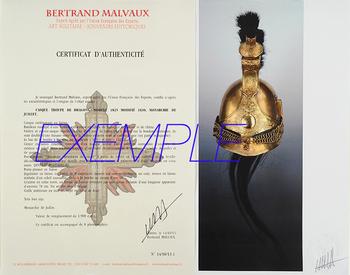
Next update Friday, december 26 at 13:30 PM
FOR ALL PURCHASES, PAYMENT IN MULTIPLE CHECKS POSSIBLE
bertrand.malvaux@wanadoo.fr 06 07 75 74 63
SHIPPING COSTS
Shipping costs are calculated only once per order for one or more items, all shipments are sent via registered mail, as this is the only way to have proof of dispatch and receipt.
For parcels whose value cannot be insured by the Post, shipments are entrusted to DHL or Fedex with real value insured, the service is of high quality but the cost is higher.
RETURN POLICY
Items can be returned within 8 days of receipt. They must be returned by registered mail at the sender's expense, in their original packaging, and in their original condition.
AUTHENTICITY
The selection of items offered on this site allows me to guarantee the authenticity of each piece described here, all items offered are guaranteed to be period and authentic, unless otherwise noted or restricted in the description.
An authenticity certificate of the item including the description published on the site, the period, the sale price, accompanied by one or more color photographs is automatically provided for any item priced over 130 euros. Below this price, each certificate is charged 5 euros.
Only items sold by me are subject to an authenticity certificate, I do not provide any expert reports for items sold by third parties (colleagues or collectors).
FOR ALL PURCHASES, PAYMENT IN MULTIPLE CHECKS POSSIBLE
bertrand.malvaux@wanadoo.fr 06 07 75 74 63
An authenticity certificate of the item including the description published on the site, the period, the sale price, accompanied by one or more color photographs is automatically provided for any item priced over 130 euros. Below this price, each certificate is charged 5 euros.
Only items sold by me are subject to an authenticity certificate, I do not provide any expert reports for items sold by third parties (colleagues or collectors).
